Kivitoa
Kokaõpilane 2009-05-20 02:33:19 |
Otsin Stornoway Black Pudding'u retsepti Sai käidud Šotimaal ja sai söödud Stornoway linnas nende kuulsat verivorsti. Mujal šotimaal proovitud verivorstid pold pooltki nii head, kui Stornoway kraam. Google ei anna kah midagi. Paistab suur saladus olema. Otsin sellist retsepti, mis õpetaks Stornoway verivorsti ise kodus tegema. Samuti otsin ka autentset Haggis'e retsepti. Paar Hagis'e õpetust, mis netist leidsin ei klapi kuidagi sellega, mida kohapeal suhu pistsin. Tänud vastajatele! | |
|
Pille Nami-Nami peakokk 2009-05-20 07:47:25 |
Kivitoa:
Aga mis on autentne haggis, Kivitoa? Šotimaa on suur ja lai, eri piirkondades valmistatakse haggist erinevalt, igal lihunikul on oma "salastatud" maitsesegu haggise haoks. Mina elasin seitse aastat Edinburghis ja proovisin väga erinevaid haggiseid selle aja jooksul. Maitseid ja maitseelamusi oli seinast seina. Lõpuks jäin truuks laialdaselt saadaolevale Macsween of Edinburghi omale ja seda sõin igati regulaarselt (st kindlasti mitte ainult kord aastas Burns Supperi ajal). Siinsamas Nami-Nami retseptikogus olev retsept on minu arust küllaltki autentne, kuigi ei pruugi olla sama maitsega, mida Sina Šotimaal said.
Samuti otsin ka autentset Haggis'e retsepti. Paar Hagis'e õpetust, mis netist leidsin ei klapi kuidagi sellega, mida kohapeal suhu pistsin. Kivitoa:
Stornoway Black Pudding ehk Marag Dubh on Isle of Lewise "pealinna" Stornoway järgi nime saanud verivorst (mis konsistentsilt meenutab küll pigem meie verikäkki). Põhikomponentideks on jämeda jahvatusega Šoti kaerajahu, peenestatud sibul, ploomirasv, värske veri ning vürtsid. Kas tegemist on veise- või lambarasva ja -veregea, selles osas jäävad vorstivalmistajad kidakeelseks ja salapäraseks. Kõige parimat ja autentsemat ja õigemat teevad väidetavalt neli Stornoway lihunikku - WJ MacDonald e. 'Willie John’s' (retsept aastast 1931), Macleod & Macleod (retsept aastast 1931), Charles MacLeod ehk 'Charley Barley' (retsept aastast 1947).
Kuna toode on populaarne, siis analoogi valmistatakse ka mujal Šotimaal ja isegi Inglismaal, kus seda siis kutsutakse "Stornoway Style Black Pudding". Mullu alustati allkirjade kogumist Stornoway Black Pudding'i toetuseks ja tänavu jaanuaris kohtus Highlands & Islands valimispiirkonna esindaja Šoti Parlamendis (Holyrood), leiborist Rhoda Grant, Brüsselis vajalike instantsidega, et kaitsta Stornoway Black Puddingu nime ja retsepti kõiksugu kopeerijate eest. Nii et tõepoolest hästi hoitud ja kaitstud saladus :)
Retsepti mul kahjuks jagada pole :(
Otsin Stornoway Black Pudding'u retsepti Sai käidud Šotimaal ja sai söödud Stornoway linnas nende kuulsat verivorsti. Mujal šotimaal proovitud verivorstid pold pooltki nii head, kui Stornoway kraam. Google ei anna kah midagi. Paistab suur saladus olema. Otsin sellist retsepti, mis õpetaks Stornoway verivorsti ise kodus tegema. |
|
Kivitoa
Kokaõpilane 2009-05-20 14:15:33 |
Autentse hagis'e retsepti all mõtlen sellist, mis on võimalikult vähe netiavarustes ringi liikunud ja muteerunud. Netis olevad retseptid on teinekord edastatud/ümber kirjutatud inimeste poolt, kel pole asjast vähimatki aimu. Nii võib leida ebaadekvaatseid soovitusi asendada koriandri puudumisel see peterselliga (ilmselt lehe kuju sarnasuse tõttu) ja tamarindi asemel soovitatakse ketšupit kasutada. Kui Sa ütled, et see hagis'e retsept siin on ok siis proovin ta kindlasti ära. Sinu nimetatud neljast Stornoway lihunikust külastasin kahte ja nende hagis'ed olid nagu öö ja päev. Macleod & Macleod'i oma oli hästi vürtsikas ja kuiv, tahtis kurku kinni jääda ja lämmatada nagu ameeriklaste rahvushirm ja -arm peanut butter. Seevastu oli nende verivorst aga kõigi verivorstide valitseja. WJ MacDonaldi hagis sulas aga suus kui mesi ja köögis hõljus eestimaa augustikuine viljakuivatite lõhn. Stornoway verisvorsti Brüsseli juttu olen kuuld isegi. Lihunik Charles MacLeod on vist see põhiline eestkõneleja seal kohapeal. Pille, kas oled seda jämeda jahvatusega kaerajahu kuskil eestis ka näinud? Ja mis on need vürtsid, mis seal sees võiks käia (majoraan, vürts, pipar)? Tundub, et eri loomade vered ja rasvad on seal elegantses vahekorras läbi miksitud. Tunda oli väga kerget lambamekki, samas ei ole mõeldav, et kogu rasvaine oleks seal lambarasv, sest siis oleks asi kindlasti väga kasukane. Tänud ka pika posti eest! | |
|
Pille Nami-Nami peakokk 2010-09-06 19:18:34 |
Ühest veebifoorumist pärit marag dubh'i retsept: Scottish Black Pudding 1 pound suet, finely chopped 1 pound oatmeal 2 onions fresh sheep's blood (may be watered down) salt and pepper to taste Mix dry ingredients in a bowl with fresh sheep's blood. Stuff mixture into casing, tie well. Place in large pan, cover with boiling water, boil gently for 3 hours. Remove black puddings, allow to cool. Cut into slices as required, fry in hot fat. NOTES : Called 'Marag' (Blood Pudding) in Gaelic (it also means a fat, shapeless person!), this is one of the famous blood dishes that Scottish people love. It usually accompanies other fried dishes, such as bacon and eggs. While it might seem shocking to eat blood, don't forget that all meat dish contain blood and it's the basis, with fat, of gravy. Blood dishes are popular all over Europe, especially in Transylvania. If serving to children, experience shows that the ingredients are best left undiscussed at the table. Black puddings and mealie puddings are usually stuffed in larger sausage casings of the size used for garlic and other specialty sausages. Kommentaar: Mike from Oregon originally from Stornoway Ive been trying to perfect this recipe for 4 years now. The previous 3 years i used Pigs blood but this year I have found that Lambs blood is much sweeter. I have also found that 1.5 tablespoons of salt and 3/4 tablespoon of salt for every pound of suet works well. | |
|
Pille Nami-Nami peakokk 2010-09-06 19:20:35 |
Haggise retsept Guardianis, sh samm-sammult fotod: :D Kopeerin siia ka - juhuks, kui Guardian peaks selle teksti miskipärast kustutama :) The haggis challenge As the 250th anniversary of Robert Burns' birth approaches, a haggis hater takes his life in his hands Haggis If you cut into the haggis while it's still piping hot, the casing will retract and the stuffing will ooze out appealingly. Photograph: Tim Hayward Like many Englishmen, my understanding of haggis is limited. For me it's a vac-packed softball of mince and porridge, by turns challenging and depressing, purchased, if at all, once a year from a tartan plastered fixture in an English deli. Travelling north I've had it sliced and reheated, slipped into 'Scottish' breakfasts and ponced up into rissoles in themed restaurants but I never understood why a proud nation whose fields, streams and woods produce some of the best food in the world would ever want to call this comedy gut-puck their national dish. I polled Scottish foodie friends who told me a) I just didn't get it (but then I was English so I wasn't meant to) b) what was all this once a year nonsense? And c) if an Englishman ever wrote about it he'd get lynched. Am I really missing the point. Should we be eating this fabulous thing all year round? I decided I'd try to cook one from scratch, write about it and see if WoM's sizeable Scottish contingent would let me live. So. Here's my step by step picture guide to doing your own haggis - the recipe's below. As usual, I'll do my best to answer any questions you have (polite ones). Haggis Pluck Here's the 'mise'. The pluck, coarse oatmeal, suet, ox bung and onions. Seasonings are still in the cupboard. Photograph: Tim Hayward First of all. A sheep's 'pluck' is the windpipe, lungs, heart and liver which you'll need to order direct from a butcher. If you've been good to him all year, he probably won't charge you. Slaughter regulations mean that any food-safe pluck will have had the windpipe removed and the lungs will have been cut across for inspection. This makes little difference as, in traditional recipes, the windpipe was merely hung over the edge of the pot to remove 'impurities' (read sheepsnot) and not included in the stuffing. You will, however, have to keep your eye on the simmering pot as the same 'impurities' can cause a disturbing brown froth to form if boiled too hard. Not in any way to the detriment of the finished product but visually reminiscent of something in a cheap 50's sci-fi shocker. Haggis was traditionally packed into the sheep's fourth stomach or rumen. These are difficult to obtain from English butchers as anything with the slightest possibility of 'fecal contamination' requires special cleaning and there's tragically not enough demand down here. The best alternative, ox bung, is available from specialist sausage suppliers and comprises the last yard or so of the large intestine of a cow cleaned and salted. You'll also need, coarse oatmeal (500g) and rosemary, sage, thyme and savory. If you can get it, 500g of lamb suet will add yet more flavour but you can substitute packaged, refined suet as I did. You'll also need salt, pepper and butcher's string. Though the recipe is simple, scaling it is almost impossible. Ox bungs don't come in standard sizes and sheep plucks range in size from something that might comfortably squeeze into a large breakfast bowl to something you'd have trouble beating into a wheel barrow with a stick. I filled my bung in two pieces, ending up with a 2kg and a 850g haggis. Unless you're lucky (as I was) or incredibly clever, you should expect to throw away either some stuffing or some bung. On the other hand, as total ingredient cost will come in at something under £3.00 this shouldn't be too painful. Making it To be used with my step by step picture guide Wash the pluck and simmer it gently in unsalted water until it's tender - usually about and hour and a half. Let it cool overnight in its own cooking liquid. Chop the heart and lungs finely - I used a mezzaluna but a food processor will do the job if pulsed gently. Remember that you're looking for a gravelly texture, not pate. Grate the liver - a weird and strangely satisfying sensation. Toast the oatmeal for a few minutes in a medium oven while chopping the onions. Season the meat with salt, coarse ground white pepper, sage, thyme, rosemary and savory. There's no need to go overboard here - particularly with the pepper. This isn't, after all, an English sausage. Add the onions, the oatmeal, the suet and a pint or so of the liquid in which the pluck was poached. The mix should be moist but not enough to hold together as a single mass. The ox bung will have been thoroughly cleaned and salted so rinse it inside and out with clear water and pat it dry with a kitchen towel. Spooning the stuffing into the bung until it's half full; I wanted to make two so I stopped early and cut off the bung short. Expel any air left in the casing, tie the opening tightly with several turns of butcher's string and work the filling back out into the full length of the casing. The stuffing will expand in cooking as the oatmeal absorbs the fat and meat juices. The most important trick is to allow space for this expansion whilst preventing any air bubbles which might turn the entire thing into a meat-based Hindenberg disaster. Lower the haggis into gently simmering water. The casing will contract and the stuffing will swell. Use a skewer to pierce and release any trapped air. Remember that cooking time is based on thickness not mass; the long sausage shape of the bung means that this one took just over an hour and a half to cook. Lift out onto a plate and pat dry. I've never been to a Burns Night dinner so I've never had the full experience of the piped in pudding, the declaiming, the toasts, but having cooked a full-sized battle haggis I'm beginning to understand it. This is a genuinely monumental piece of food. There's something about the steaming, bulging shape of it, the astonishingly welcoming smell that could easily inspire ritual and poetry in a nation less emotionally constipated than the English. And the taste…. oh the taste. I can't remember ever eating anything quite so rich. The grains absorb the fats and flavours, the powerful aromas of the meat are dispersed throughout; the velvet liver is offset by a slight nutty texture - it's a comprehensive and completely astonishing sensory assault. With the combination of fat richness and slight livery aftertaste I found myself thinking of foie gras - but more fun. Am I converted? Absolutely. I was led astray by cheap ersatz haggis, by fear of guts and generations of bad jokes but now I see the light. I'm completely sold on haggis ... so string me up. Now, pull up a chair, pour yourself a glass and tell me your haggis story. Tim Hayward Friday 23 January 2009 10.00 GMT guardian.co.uk In pictures: a step-by-step guide to making your own haggis Tarku väljavõtteid artikli juures olevatest kommentaaridest: [i]* Whiskey after haggis not before, otherwise you dont get the appreciation of the flavours of either. * Since it's already cooked when you buy it (if you buy it), you can reheat it any old way: boil again, microwave, bake wrapped in foil, bain-marie... And a small amount of whisky poured over it lifts the dish to a whole new realm of splendour! * That's the first time I've ever read a recipe for the stuff, well done laddie! But I think I'll just continue with the McSween's (nearly) ready version thankyou. It's too rich to eat all the time but there's no doubt that the combination of haggis, neeps and tatties (turnip and mash potato) is one of the great peasant food combinations of all time. It is extra specially good with a small whisky but PLEASE do not pour the stuff over the food YEUCH!!. The best wine to go with it is apparently a light Anjou Rouge which I serve for those who don't want their annual dose of rocket fuel although scientific analysis has proved that whisky makes you dance quicker than red wine. * I've eaten terrible haggis in a pub on the royal mile in Edinburgh and marvellous haggis made by the local butcher in the village of Airth. They can vary enormously. * TIM HAYWARD: Just had a couple of slices fried up for lunch, topped with a poached FR egg. Pretty much stunning. This stuff gets better and better. Once the big one had cooled down the skin contracted further and took on a sort of translucence so you could see more of the insides - looked much more like the packaged versions. It set up as solid as a well packed salami and sliced beautifully. The flavour has changed too. When really steaming hot and 'gashed' open, it's soft, fudgy and has that lovely combination of fat and liver. After a couple of days it mellows so there's no trace of liveriness left - in fact it's a very reminiscent of good black pudding. I've now sliced up the substantial remains and frozen them. I won't have a fried breakfast for at least the next six months without it. @CommanderKeen When I first tried it I suddenly saw what the whisky thing was all about. The fattiness, particularly with commercial suet, is part of the appeal but it really coats the mouth. Frankly, a raw alcohol mouthwash seemed the only solution. A Scottish chef friend said that this was the reason it was one of the few dishes worldwide that paired really well with spirits. I passed this comment on to an Italian friend, a really keen home cook from Modena, who said that for the really fatty, offally peasanty meats - home-made cottechino was her example - her family always saved the cheap sparkling reds for that same 'greasecutter' quality. Wine isn't my strong point and I can't imagine any food writer has ever gone on record with this and kept their job but it looks like we could be pairing Lambrusco and haggis. * Of course the wine/whisky dilemma can be easily solved by mixing the two in what used to be marketed as Scotsmac, aka 'Wham's Dram' , a delicate blending of the finest wines and rarest Scottish Whiskies in the one bottle. It was the tipple du jour of many a happy Glaswegian and I understand was an essential precursor to some impromptu reeling. | |
|
Pille Nami-Nami peakokk 2012-01-22 08:25:44 |
Pille:
Nüüd on selline asi, et ma saan (ilmselt kolmapäeval) ühe lamba sisikonna (ingl. k. the pluck) ja asun hägist tegema. Siinkohal Tim Haywardi fotod ajalehest The Guardian. Pärast asendan oma fotodega :O
Hägise komponendid: sisikond (kops, maks, süda ja hingetoru), kaeratangud, neerurasv, sibulad ja veisemagu. Vürtsid on hetkel veel kapis:
Haggise retsept Guardianis, sh samm-sammult fotod: :D Kopeerin siia ka - juhuks, kui Guardian peaks selle teksti miskipärast kustutama :) The haggis challenge As the 250th anniversary of Robert Burns' birth approaches, a haggis hater takes his life in his hands 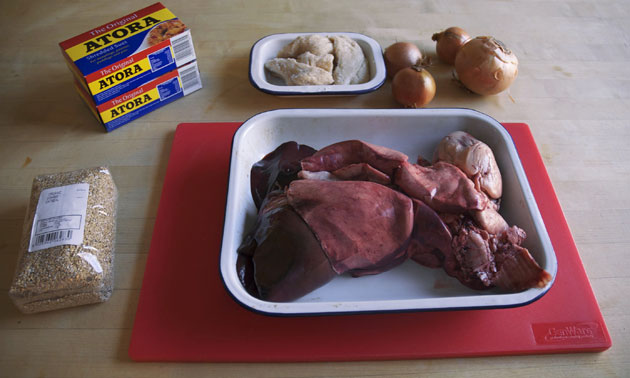 Rupsid on pestud ja keedetakse tasakesi magedas vees pehmeks (ca 1,5 tundi). Siis lastakse neil keeduleemes jahtuda järgmise päevani:
Rupsid on pestud ja keedetakse tasakesi magedas vees pehmeks (ca 1,5 tundi). Siis lastakse neil keeduleemes jahtuda järgmise päevani:
 Peale pooleteisttunnist keetmist näeb liha välja selline:
Peale pooleteisttunnist keetmist näeb liha välja selline:
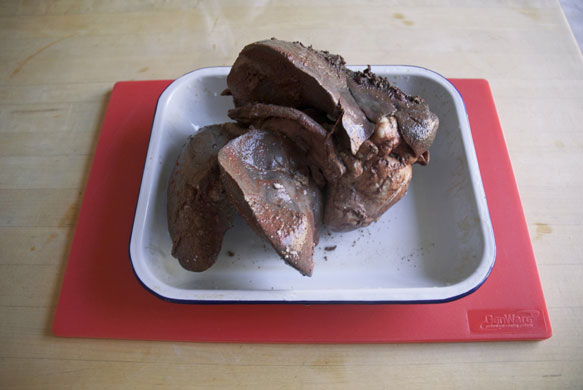 Alates ülemisest paremast nurgast - süda, kaks kopsu, kaks maksapoolikut:
Alates ülemisest paremast nurgast - süda, kaks kopsu, kaks maksapoolikut:
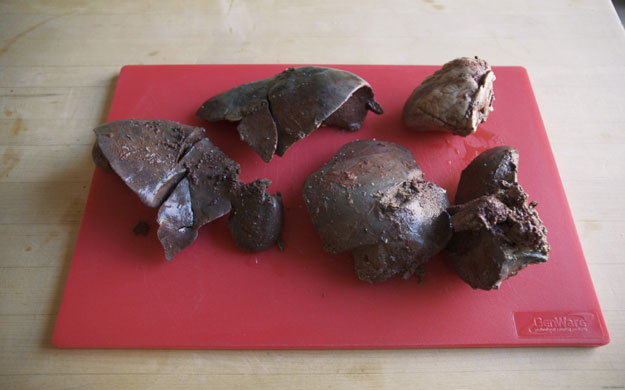 Haki süda ja kopsud peenikeseks - vaja on jämedakoelist massi, mitte pasteeti. Riivi maks jämedal riivil:
Haki süda ja kopsud peenikeseks - vaja on jämedakoelist massi, mitte pasteeti. Riivi maks jämedal riivil:
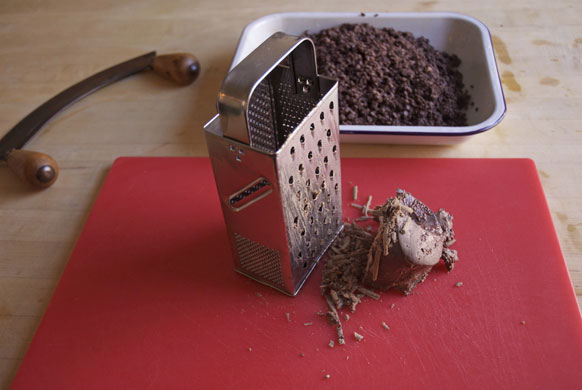 Haki sibulad:
Haki sibulad:
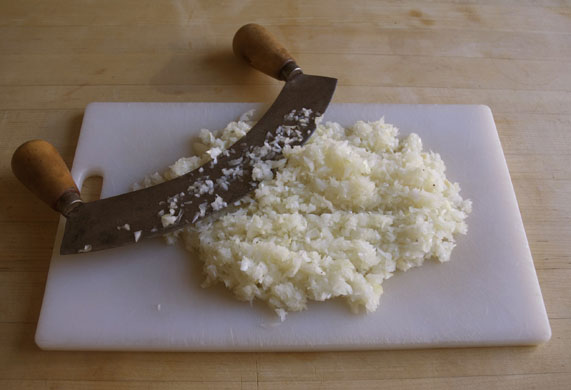 Rösti kaerajahu kuldseks:
Rösti kaerajahu kuldseks:
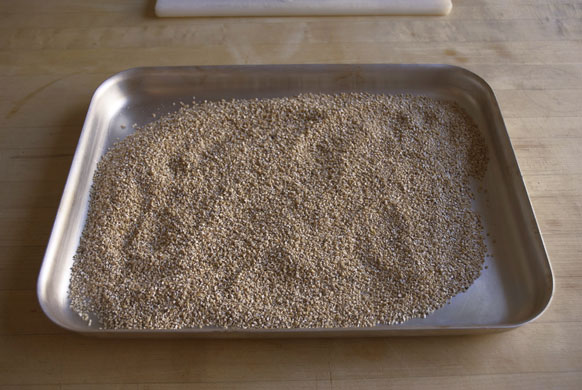 Lisa hakitud sibul hakitud rupskitele, maitsesta soola, valge pipra, salvei, tüümiani, rosmariini ja piparrohuga:
Lisa hakitud sibul hakitud rupskitele, maitsesta soola, valge pipra, salvei, tüümiani, rosmariini ja piparrohuga:
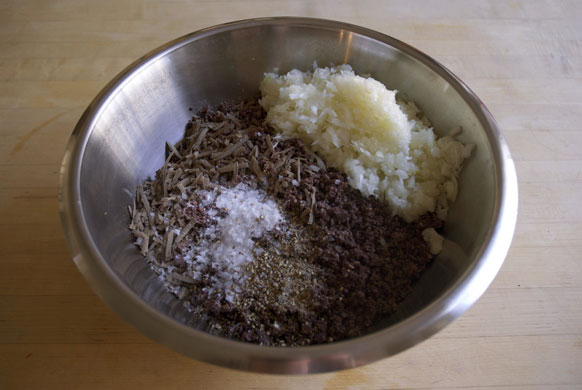 Lisa kaerajahu, riivitud neerurasv ja umbes pool liitrit keeduleent. Segu peab olema niiske, aga mitte ühtlane:
Lisa kaerajahu, riivitud neerurasv ja umbes pool liitrit keeduleent. Segu peab olema niiske, aga mitte ühtlane:
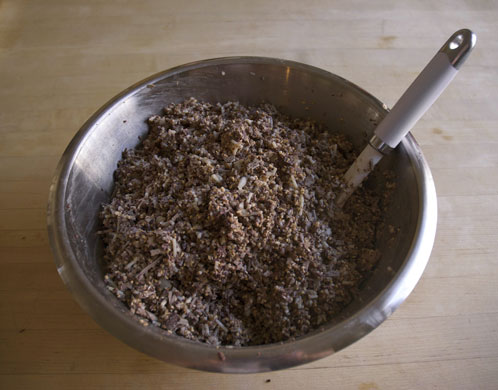 Veisemagu on korralikult pestud ja soolvees hoitud. Loputa hoolega puhta veega, patsuta köögirätikuga kuivaks ja laota vaagnale.
Veisemagu on korralikult pestud ja soolvees hoitud. Loputa hoolega puhta veega, patsuta köögirätikuga kuivaks ja laota vaagnale.
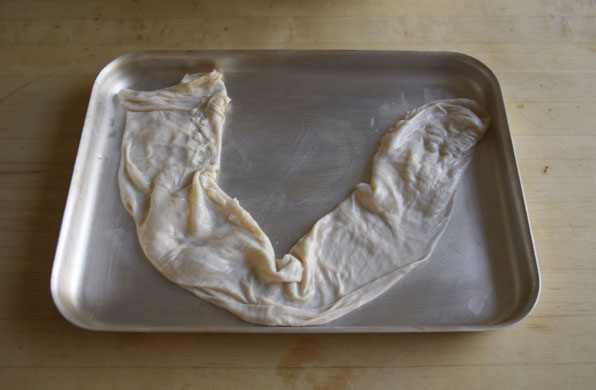 Tõsta hägisesegu mao sisse, täida see poolenisti. (Tim Hayward tegi kaks eraldi hägist, seepärast ka poolitatud magu fotol). Liigne õhk suru välja.
Tõsta hägisesegu mao sisse, täida see poolenisti. (Tim Hayward tegi kaks eraldi hägist, seepärast ka poolitatud magu fotol). Liigne õhk suru välja.
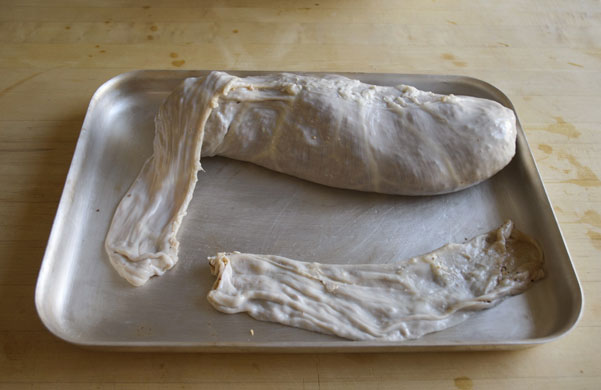 Seo nööriga korralikult kinni:
Seo nööriga korralikult kinni:
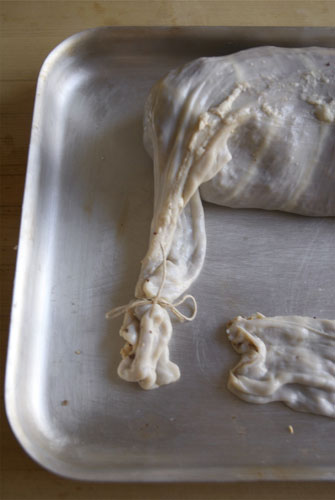 Nüüd jaota täidis mao sees ühtlaselt:
Nüüd jaota täidis mao sees ühtlaselt:
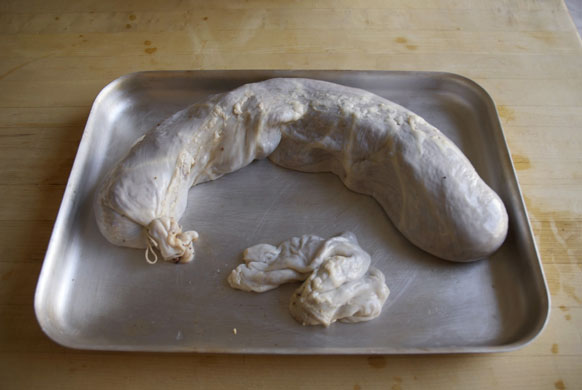 Pane hägis kergelt podisevasse vette keema. Magu tõmbab kokku ja täidis paisub. Hoia silma peal ja vajadusel tee peene sukavardaga auk sisse, et hägise lõhkemist vältida, kui mõni õhumull on sisse jäänud:
Pane hägis kergelt podisevasse vette keema. Magu tõmbab kokku ja täidis paisub. Hoia silma peal ja vajadusel tee peene sukavardaga auk sisse, et hägise lõhkemist vältida, kui mõni õhumull on sisse jäänud:
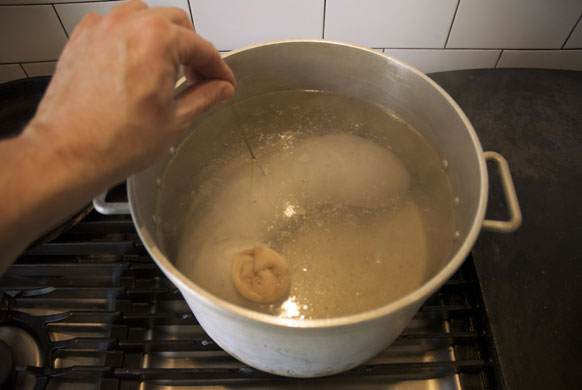 Hägise keeduaeg oleneb selle paksusest - piklik hägis on valmis umbes 1,5 tunniga:
Hägise keeduaeg oleneb selle paksusest - piklik hägis on valmis umbes 1,5 tunniga:
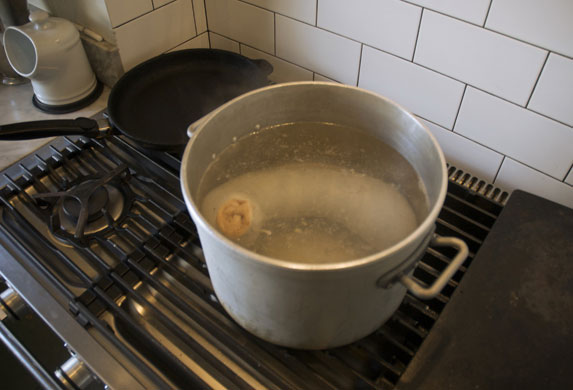 Tõsta taldrikule, lase kuivada:
Tõsta taldrikule, lase kuivada:
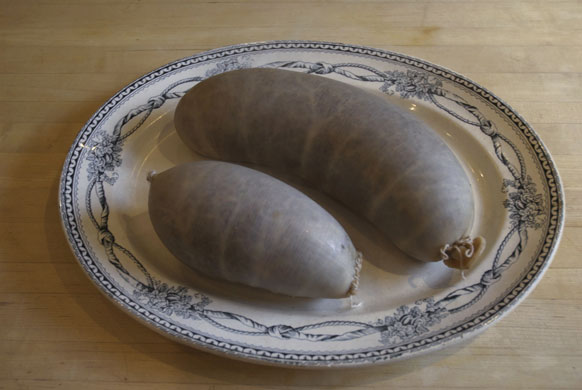 Kui nüüd veel kuum hägis noaga pooleks lõigata, siis magu tõmbub kokku ja hägise sisu valgub kenasti välja:
Kui nüüd veel kuum hägis noaga pooleks lõigata, siis magu tõmbub kokku ja hägise sisu valgub kenasti välja:
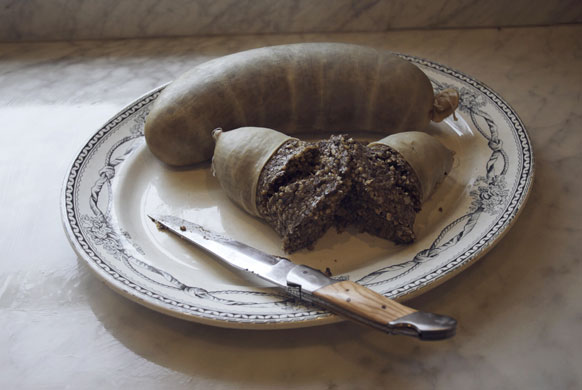 Lähivaade:
Lähivaade:

|
|
|
Pille Nami-Nami peakokk 2012-02-22 08:59:55 |
Lähen nüüd garaaži ja toon sealt selle suure kotitäie lambarupskeid kööki ning asun tegutsema. Esimesena on plaanis ülalmainitud hägis :) | |
|
Pille Nami-Nami peakokk 2012-02-26 16:14:13 |
Pille:
Mul nüüd haggis/hägis tehtud ja jäime väga rahule :) Kahjuks läksid asitõendid kaotsi, st Kristjan kustutas kogemata ära kõik fotod, mis ma valmislaotud rupskitest ja erinevatest tööetappidest tegin :( Tuleb uuesti teha :)
On olemas vaid foto võrkmaos keedetud ühest ca kilosest hägisest:
Kivitoa:
Aga mis on autentne haggis, Kivitoa? Šotimaa on suur ja lai, eri piirkondades valmistatakse haggist erinevalt, igal lihunikul on oma "salastatud" maitsesegu haggise haoks. Mina elasin seitse aastat Edinburghis ja proovisin väga erinevaid haggiseid selle aja jooksul. Maitseid ja maitseelamusi oli seinast seina. Lõpuks jäin truuks laialdaselt saadaolevale Macsween of Edinburghi omale ja seda sõin igati regulaarselt (st kindlasti mitte ainult kord aastas Burns Supperi ajal). Siinsamas Nami-Nami retseptikogus olev retsept on minu arust küllaltki autentne, kuigi ei pruugi olla sama maitsega, mida Sina Šotimaal said.Samuti otsin ka autentset Haggis'e retsepti. Paar Hagis'e õpetust, mis netist leidsin ei klapi kuidagi sellega, mida kohapeal suhu pistsin.  Kuna ma asendasin nüüd retseptikogus oleva hägiseretsepti sellega, mis ma ise sel nädalal tegin, siis kopeerin eelmise retsepti siia. Ehk on kellelgi vaja.
HAGGIS
(Kuri)kuulus roog Šoti köögist.
Et valmistada haggist on vaja:
1 lamba sisikond - st
maksa
südant
kopsu
külma vett
1 lamba magu
450 g kergelt röstitud jämeda jahvatusega kaerajahu
1 kuni 2 sl soola
1 sl purustatud musta pipart
1 sl värskelt jahvatatud vürtspipart
1 sl kuivatatud maitserohelist (segu)
225 g hakitud ploomirasva
4 suurt hakitud sibulat
Valmistamine:
Pese lambamagu külma veega hoolega puhtaks. Leota seejärel 8-10 tundi soolases külmas vees.
Pane lamba sisikond suurde potti ja kata külma veega. Hauta tasasel tulel umbes 2 tundi, kuni liha on pehme. Lase jahtuda.
Haki keedetud lamba sisikond peeneks ja sega kaerajahuga. Lisa umbes 3 dl keeduvedelikku või puljongit.
Lisa maitseained, ploomirasv ja sibulad, sega hoolega.
Täida saadud seguga lambamagu, jättes piisavalt ruumi paisumiseks.
Suru õhk välja ja keera maole sõlm peale. Torgi terava nõelaga paar õhuauku sisse.
Pane haggis keevasse vette ning keeda tasasel tulel umbes 3 tundi.
Serveeri "haggis, neeps and tatties", st serveeri haggist koos keedetud ja katkitambitud kaalikate (lisa veidi muskaati ja võid) ja kartulitega (lisa veidi võid ja piima). Juurde 'dram' head viskit.
Allikas: John Smith, The Glasgow Cookery Book, 1962
Kuna ma asendasin nüüd retseptikogus oleva hägiseretsepti sellega, mis ma ise sel nädalal tegin, siis kopeerin eelmise retsepti siia. Ehk on kellelgi vaja.
HAGGIS
(Kuri)kuulus roog Šoti köögist.
Et valmistada haggist on vaja:
1 lamba sisikond - st
maksa
südant
kopsu
külma vett
1 lamba magu
450 g kergelt röstitud jämeda jahvatusega kaerajahu
1 kuni 2 sl soola
1 sl purustatud musta pipart
1 sl värskelt jahvatatud vürtspipart
1 sl kuivatatud maitserohelist (segu)
225 g hakitud ploomirasva
4 suurt hakitud sibulat
Valmistamine:
Pese lambamagu külma veega hoolega puhtaks. Leota seejärel 8-10 tundi soolases külmas vees.
Pane lamba sisikond suurde potti ja kata külma veega. Hauta tasasel tulel umbes 2 tundi, kuni liha on pehme. Lase jahtuda.
Haki keedetud lamba sisikond peeneks ja sega kaerajahuga. Lisa umbes 3 dl keeduvedelikku või puljongit.
Lisa maitseained, ploomirasv ja sibulad, sega hoolega.
Täida saadud seguga lambamagu, jättes piisavalt ruumi paisumiseks.
Suru õhk välja ja keera maole sõlm peale. Torgi terava nõelaga paar õhuauku sisse.
Pane haggis keevasse vette ning keeda tasasel tulel umbes 3 tundi.
Serveeri "haggis, neeps and tatties", st serveeri haggist koos keedetud ja katkitambitud kaalikate (lisa veidi muskaati ja võid) ja kartulitega (lisa veidi võid ja piima). Juurde 'dram' head viskit.
Allikas: John Smith, The Glasgow Cookery Book, 1962
|
|
|
Pille Nami-Nami peakokk 2013-04-05 18:56:27 |
Käisin 24.3.2013 Aegviidus, kus ühe kohaliku MTÜ Ajaleidja eestvõtmisel juhendasin Šoti köögi töötuba. Üritus toimus Aegviidu lasteaia köögis-söögitoas ja rahastas PRIA. Menüüs olid: kaeraküpsised praetud verikäkid skirlie-seguga tattie scones suitsutursasalatiga cock-a-leekie supp ahjulõhe sinepi-kaerahelbekattega clapshot porrud koorekastmes cranachan Vähemalt mulle tundus, et korraldajad-kutsujad jäid rahule. Šoti köök on tegelikult väga-väga mõnus :) | |
|
Pille Nami-Nami peakokk 2014-02-12 20:18:17 |
Ülle Jukk kirjutab oma blogis väga kaunilt ühest Hiiumaal aset leidnud Burnsi õhtusöögist: Öös oli asju ehk öös oli šotlasi | |
| < 1 | 2 > >> | ||